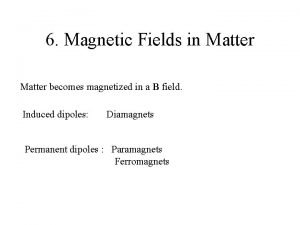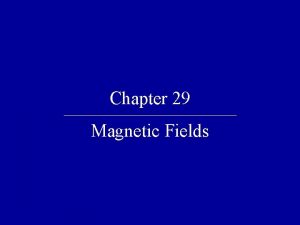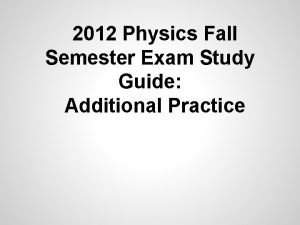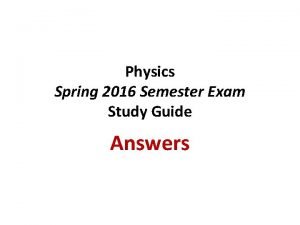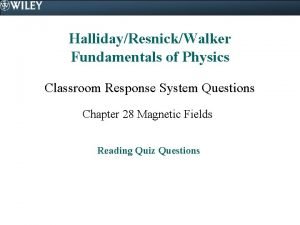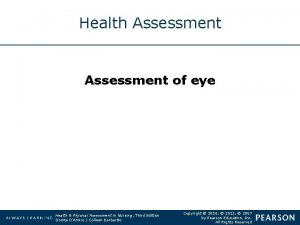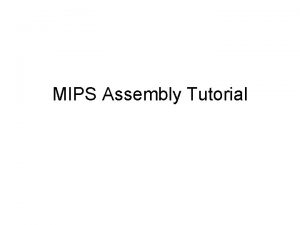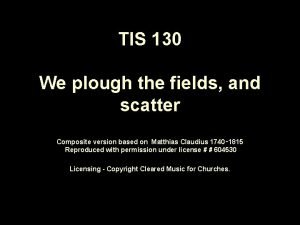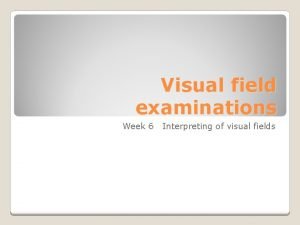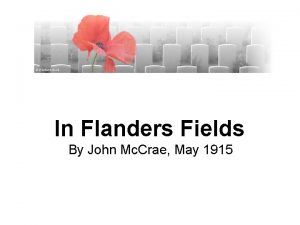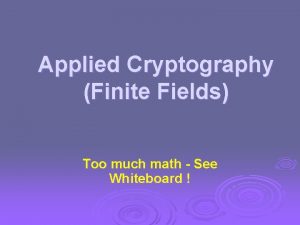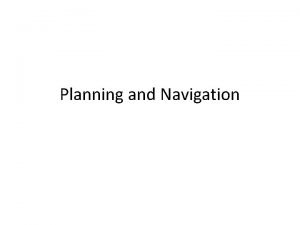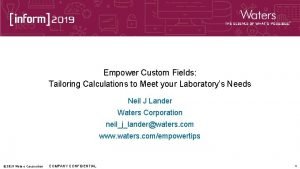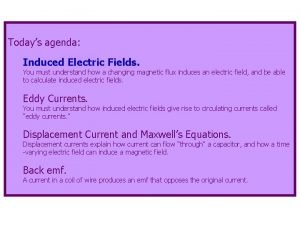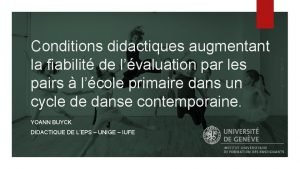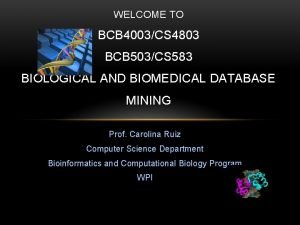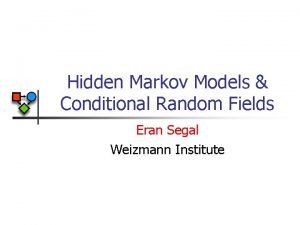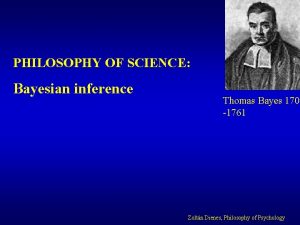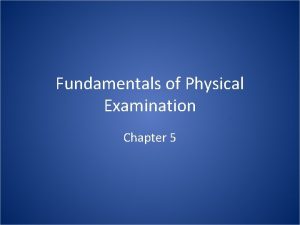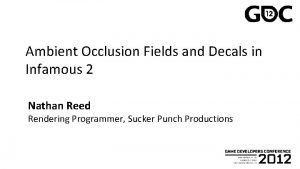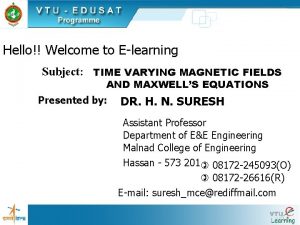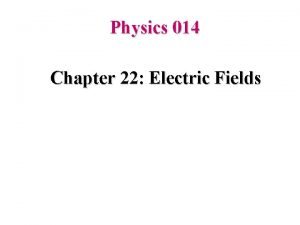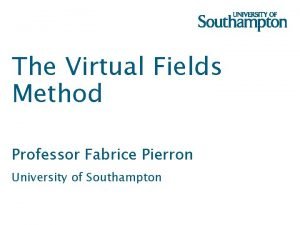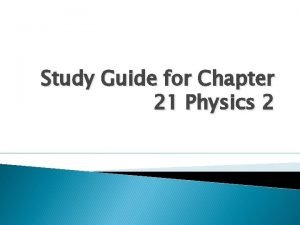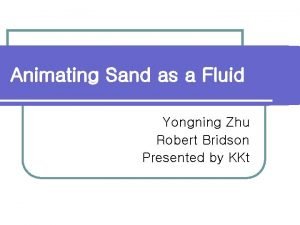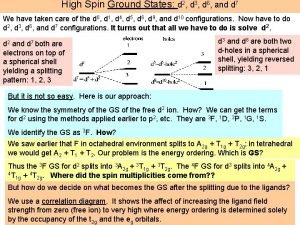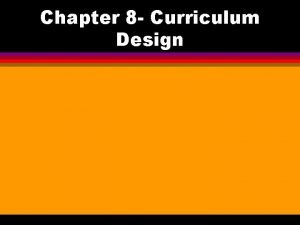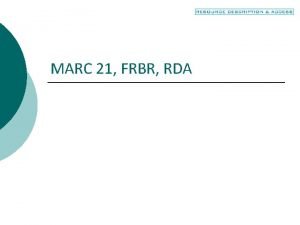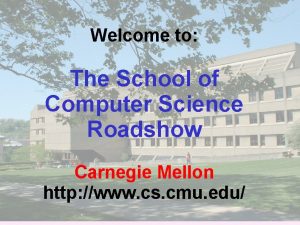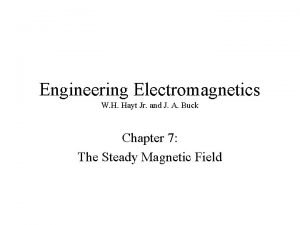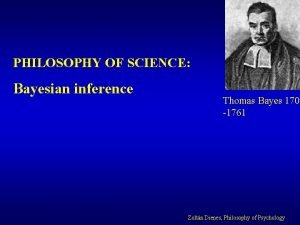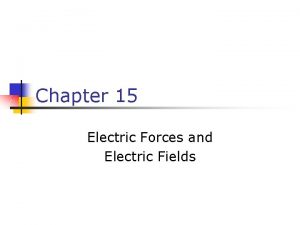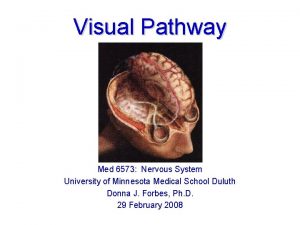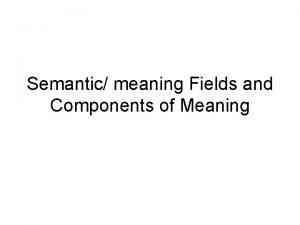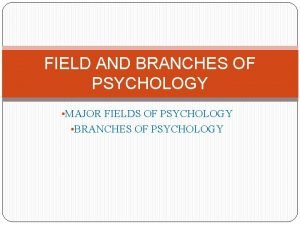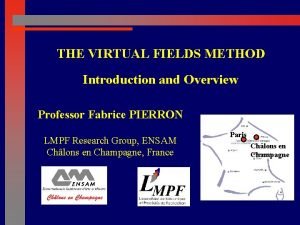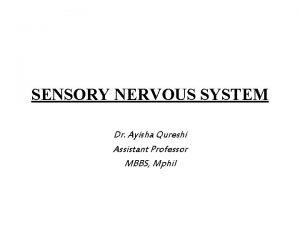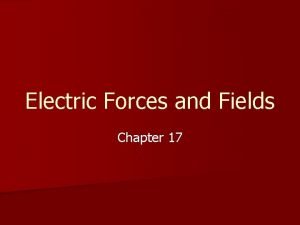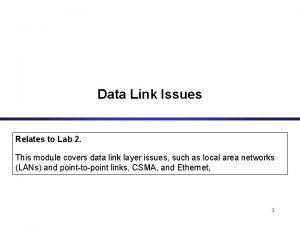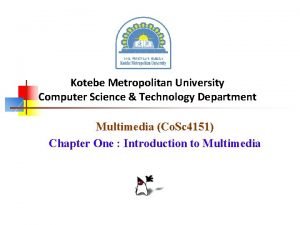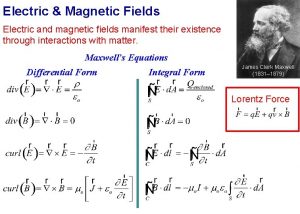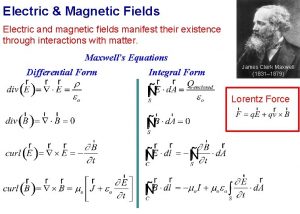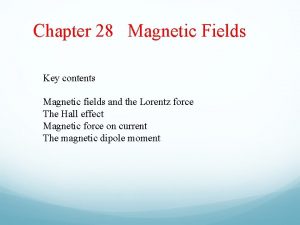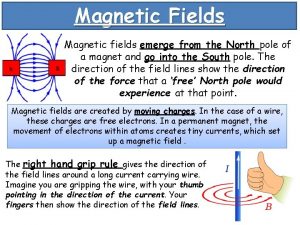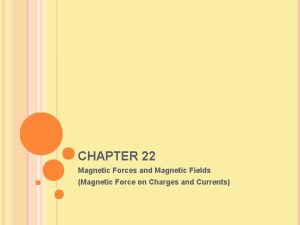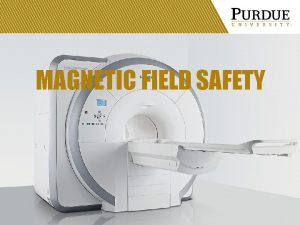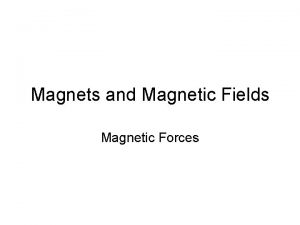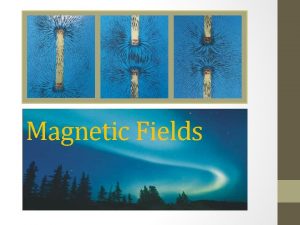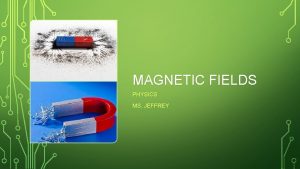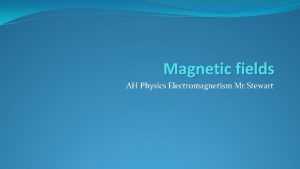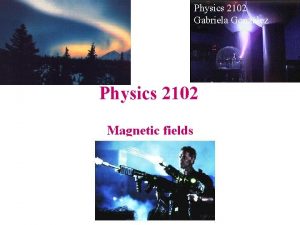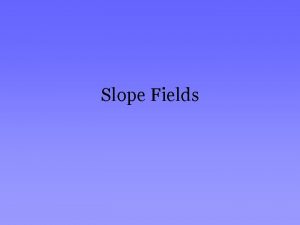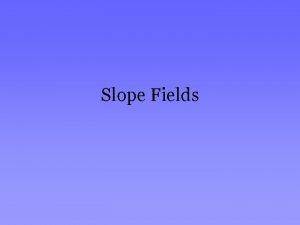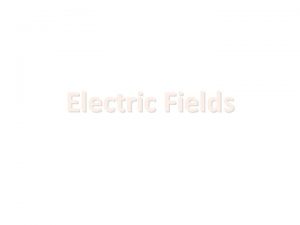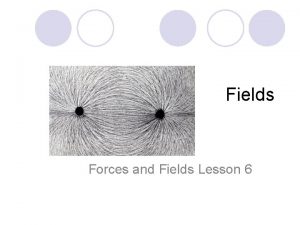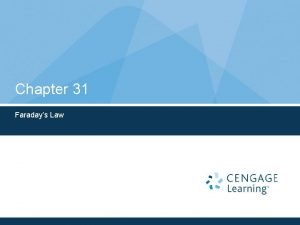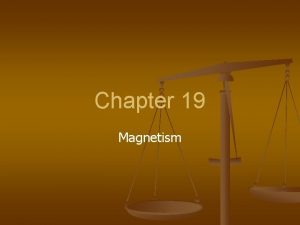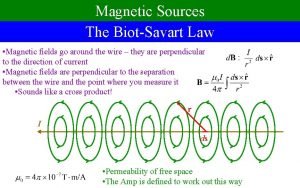AP Physics Magnetic Fields 2 nd SEMESTER WEEK






















































































- Slides: 86

AP Physics Magnetic Fields 2 nd SEMESTER, WEEK 10 -11 -12 Mr. Crofoot RIM High School

Fields 3/15/17 Starter / Plicker A quadrupole mass spectrometer uses dynamic electric fields to separate charged ions. Which statement best describes how a quadrupole mass spectrometer works? a) Ions are accelerated toward the quadrupole by applying a potential from B to C, then masses are separated by applying a sine potential between A and D. b) Ions are accelerated toward the quadrupole by applying a potential from A to D, then masses are separated by applying a sine potential between B and C. c) Ions are accelerated toward the quadrupole by applying a potential from A to B, then masses are separated by applying a sine potential between C and D, D A B C d) Ions are accelerated toward the quadrupole by applying a potential from B to D, then masses are separated by applying a sine potential between A and C,

Relativity, 3/15/2017 Prep for Video Time dilation. Reference frame Motion is relative Clocks on a space ship Time dilation. cto Mirrors ct vt

Magnetic Fields 3/15/17 Interactive Notebook, Watch Video Magnetic Fields are Actually Electric Fields in a Different Frame of Reference, Special Relativity https: //www. quora. com/Why-doesnt-a-magnetic-field-do-any-work-on -a-charge

Magnetic Fields 3/15/17 Interactive Notebook, Write on page 31 • A Magnetic Field is represented by the vector B • Unlike electric fields, there are no known single points of magnetic sources • Magnetic Fields are produced between two opposite poles. • Magnetic Fields only produce forces on charged particles if the charged particle and field have motion between them. Comparison of Magnetic Field to Electric Field FE = E q FB = qv x B Right Hand Rule

Right Hand Rule Ф Practice Exercise Notebook page 32 Page 738. Check Point 1 Page 757. Problem 2

Magnetic Fields 3/16/17 Starter / Plicker What is the force and direction (wrt x-axis) on a -1 coulomb particle moving 5 m/s in a uniform magnetic field (10 -2 T) into the page as indicated in the drawing. a) F=│ q│ v x B sin Ф = 0. 050 N at 150° b) F=│ q│ v x B sin Ф = 0. 043 N at 150° c) F=│ q│ v x B sin Ф = 0. 050 N at 330° d) F=│ q│ v x B sin Ф = 0. 043 N out of page X B= 10 -2 T 60°

Magnetic Fields 3/16/17 Interactive Notebook, Write on page 33 Path of Charged Particle in a Uniform Magnetic Field Because the force is always perpendicular to the velocity vector moving perpendicular to a uniform magnetic field, the path of a charged particle with constant speed is circular. FB = qv x B F Right Hand Rule v - X B= 10 -2 T

Magnetic Fields 3/16/17 Interactive Notebook, Write on page 33 •

Magnetic Fields 3/16/17 Interactive Notebook, Write on page 33 •

Magnetic Fields 3/16/17 Interactive Notebook, Write on page 34 • y Thomson used this experiment to determine the mass to charge ratio of what he discovered to be the electron.

Magnetic Fields 3/16/17 Interactive Notebook, Write on page 34 - + E ee- y Hall Effect Charge Carriers • Assume that electrons are the charge carriers • Then they flow in the opposite direction of the traditional current. • The magnetic force will then push the electrons to the left on the drawing. • This leaves positive charge on the right, from which an electric field develops, which results in a measurable voltage, V=Ew • Since the measurable voltage has positive on the right and negative on the left, this proves that negative electrons are the charge carriers. • Positive charge carriers would flow the opposite direction and result in a voltage with positive on the left and negative on the right.

Magnetic Fields 3/16/17 Interactive Notebook, Write on page 34 Hall Effect, Drift Elections Speed and Density • The electric field from the Hall Effect is in equilibrium with the magnetic field: E = V/w e. E = ev. B • Electron drift speed is: v = i/ne. A • Combining these equations and solving for electron density: n = Biw/Ve. A n= Bi/Vde where d=A/w • All of these variables are measurable and tell us that each metal atoms contributes about one drift electron. y

Magnetic Fields 3/16/17 Interactive Notebook, Write on page 34 Hall Effect, Drift Electrons Speed and Density • If we move the metal strip in the opposite direction and speed of the drift electrons, the Hall Potential disappears. • This provides us a means to measure the drift speed. • The drift speed for electrons is quite slow, cm/hour. • Practice Problems, page 35 of Notebook • Text page 758, problems: 7, 12 y Strip velocity

E=9. 64 E 3 N/C B=0. 02 T y=0. 02 m L=0. 20 m

Magnetic Fields 3/17/17 Interactive Notebook, Write on page 36 Cyclotron • Two copper “D” chambers are placed in a uniform magnetic field, B. • The D chambers have an alternating potential placed on them, so the electric field between the gap accelerates the charged particles, say a proton. • Recall that the frequency is: f= q. B/2πm q/m = f 2π/B • Recall the radius is: r = mv/q. B v=rq. B/m KE=1/2 m (rq. B/m)2

Magnetic Fields 3/17/17 Interactive Notebook, Write on page 36 Synchrotron • A cyclotron is limited by two factors: a) As particles approach the speed of light, its mass increases and the frequency decreases out of sink with the driving frequency. b) The radius for a 500 Ge. V proton in a magnetic field of 1. 5 G is 1. 1 km. • To fix these problems, a synchrotron a) The frequency of the electric field and magnetic field are adjusted as the particles are accelerated. b) The magnetic field is not uniform across the hollow part of the donut and only applied on the circumference.

Magnetic Fields 3/17/17 Interactive Notebook, Write on page 36 Magnetic Force on a Current Carrying Wire • The amount of charge in a wire is: q = it = i. L/v so qv=i. L • Substituting into the magnetic force equation: FB = qv x B or FB = i. LB sin Ф where L is the length of the wire in the magnetic field. • Note that the force direction is independent of the charge carrier charge. Ф •

Magnetic Fields 3/17/17 Interactive Notebook, Write on page 36 Torque on a Current Loop • When the loop is parallel with the uniform magnetic field, force on each of the two vertical wires is: FB = i. LB • Because the force is perpendicular to w, the resulting torque on the two vertical wires is: t=2 Fw/2 = i. LBw • With the current aligned with the magnetic field, the force on the horizontal wires is zero.

Magnetic Fields 3/17/17 Interactive Notebook, Write on page 36 Torque on a Current Loop • When the loop is perpendicular to the uniform magnetic field, force on each of the two vertical wires is: FB = i. LB • However, because the force is now parallel to w, the resulting torque on the vertical wires is: t=0 • The force on the horizontal wires points in opposite directions upward and downward, so has no effect on the rotational torque.

Magnetic Fields 3/17/17 Interactive Notebook, Write on page 36 Torque on a Current Loop • When the loop is not aligned with the magnetic field, the force is always perpendicular to the magnetic field. • With respect to w=b and L=a, the force working on the torque is: Ft = FB sin ѳ • Therefore: T = iab. Bsin ѳ • And the net force on the horizontal wires is: FB = 0, therefore results in no torque on loop.

Magnetic Fields 3/16/17 Interactive Notebook, Practice on page 37 Magnetic Fields and Wires Text page 759, problems: 28, 32, 39

Magnetic Fields 3/20/17 Starter / Plicker What is the kinetic energy (Me. V) of an alpha particle when it is at a radius of 1 meter in a cyclotron with B=0. 2 T, and f=60 hz? Alpha: m= 6. 64 E-27 Kg, 3. 20 E-19 C, 6. 24 E+12 Me. V/J a) 0. 0308 Me. V b) 1. 93 Me. V c) 3. 08 Me. V d) 116 Me. V


• With the thumb pointing in the direction of the current, your fingers point in the direction of the circular magnetic field.

A

A 3/2 1/2

Magnetic Fields 3/20/17 Interactive Notebook, Practice on page 40 Magnetic Fields and Wires Text page 781 - 783, questions: 1, 2, problems 7, 8

Magnetic Fields 3/21/17 Starter / Plicker Assuming the magnitude of the contribution from each of the wires is 1 T, what is the total magnetic field strength in the center of the wire sets and the angle with respect to red vector? a) A=0 T, B=1 T (180°) B A. b) A=1. 41 T (180°), B=1 T (225°) X X X c) A=2. 83 T (180°), B=2 T (225°). . d) A=0 T, B=2 T (135°) X Current going into screen . Current coming out of screen


Magnetic Fields 3/21/17 Interactive Notebook, Practice on page 41 Magnetic Fields and Wires Text page 769, Checkpoint 1 Text page 783, problems: 4, 5, 6

Magnetic Fields 3/22/17 Starter / Plicker Rank the following circuits with respect to the magnetic field strength in the center of the arcs. a) A, B, C b) C, B, A c) A, C, B d) C, A, B C B A

L ba b a

Magnetic Fields 3/22/17 Interactive Notebook, Write on page 42 Ampere is One of Seven SI Base Units • The force acting between currents in parallel wires is the basis for the definition of the ampere, which is one of seven SI base units. • The ampere is the constant current between two straight parallel conductors of infinite length that are 1 meter apart in a vacuum would produce on each wire a force of 2 x 10 -7 N per meter of wire length. L ba b a


Magnetic Fields 3/22/17 Interactive Notebook, Write on page 43 Ampere’s Law, Application • Applying Ampere’s Law to the outside of a long straight wire. ds


Magnetic Fields 3/22/17 Interactive Notebook, Practice on page 44 Magnetic Fields and Wires Text page 775, Checkpoint 3 Text page 783 - 786, problems: 7, 35, 37

Magnetic Fields 3/23/17 b a Starter / Plicker i r A hollow cylindrical conductor (inner radius = a. outer radius = b) carries a current i uniformly spread over its cross section. Which graph correctly gives B as a function of the distance r from the center of the cylinder? Use Amperes Law. B B a b A r B a b B r B a b C r a b D r

Magnetic Fields 3/23/17 Interactive Notebook, Write on page 45 Magnetic Field of a Solenoid • Helical coil of wire, with the current on the top coming out of the page and the current at the bottom going into the page. • Close to the wire the magnetic field lines are circular. • Between the wires the field lines cancel. • Inside the coil some distance from the wires, the field lines support each other and form parallel lines axial to the solenoid. • Outside the coil at points P, the upper and lower contributions tend to cancel. The field outside an ideal solenoid is zero.




Magnetic Fields 3/23/17 Interactive Notebook, Practice on page 46 Magnetic Fields and Wires Text page 781 - 783, problems: 41, 43, 45

Solenoid Lab 3/24/17 Complete Lab Report due 3/31/2017 Add to Discussion Points Compare the different values for n (turns/m) used by each lab team. We will share data on Monday.

a b c d 4 A � A. a, b, c, d B. d, d, c, a C. b, c, a, d D. b, a, d, c 9 A � 5 A � 3 A �


Magnetic Fields Test Review 3/28/17 Notebook not required, • You should know the path of charged particles in a uniform magnetic field, like a cyclotron and frequency, period, radius, force and velocity. • You should know how to work with the force on a wire and loop. And be able to interpret in terms of torque. • You should be able to calculate the magnetic field at specific points from wires and loops. • You should be able to use the right hand rule in many situations. • You should know that a magnetic field is defined by the force on a moving charged particle.

Magnetic Fields Test Review 3/28/17 Notebook not required, • You should know that magnetic field lines point from North to South poles and the general shape they take. • You should know about Crossed Electric and Magnetic Fields and that they can be used to determine the m/q. • The Hall Effect was used to determine that charge carriers are negative electrons. • The drift velocity of electrons is quite slow. • Boit-Savart Law • Units of Tesla • Difference between μo and εo

Magnetic Fields Test Review 3/28/17 Notebook not required, • You should know how to work with the force between two wires. • You should be able to use the basic principles covered before previous test. • Individual Lab Reports (Magnetism) due Friday! • We will review Test Thursday

Magnetic Fields Test 3/29/17 • Test Day • Open notebook • Write on test

Magnetic Fields Test Review 3/30/17 • Test Review Day • Lab Reports are due tomorrow. • Individual Lab Reports

Introduction to Induction and Induction 3/31/17 • Lab Reports are due today. • Individual Lab Reports

Induction and Inductance 4/10/17 Interactive Notebook, Write on page 47 • What happens to the charge carriers in a loop of wire when we push a magnetic through the loop? • What happens to the charge carriers in a loop of wire when we create a magnetic field using a second loop? N

B Magnetic Field B


Induction and Inductance 4/10/17 Interactive Notebook, Write on page 48 Lenz’s Law • An induced current has a direction such that the magnetic field due to the current opposes the change in magnetic flux that induced the current. • If the field lines are getting more concentrated, the direction of the current wants to generate field lines that oppose the direction of the field lines that are inducing the current.

Induction and Inductance 4/10/17 Interactive Notebook, Practice on page 49 Do: Page 794 Checkpoint 1 Page 797 Checkpoint 2 Page 816 Question 3

Induction and Inductance 4/11/17 Starter Plicker A Loop of Wire is subjected to six magnetic field vs. time as shown in graph. The magnetic fields are in the z-axis, the positive end of the z-axis comes out of the page. Rank the six magnetic fields with respect to the greatest clockwise current in the loop first to greatest counterclockwise current in the loop last. a) (1, 2, 5, 6 equal) then (3, 4 equal) b) 3, 1, (2, 5 equal), 5, 6 c) (1, 2 equal), (3, 4 equal), (5, 6 equal) d) 1, 2, 3, 4, 5, 6 1 3 4 6 2 5 z

Induction and Inductance 4/11/17 Example Problem, Write on page 50

Magnetism Repeat Test Review 4/11/17 No Notes Necessary

Magnetism Repeat Test 4/12/17 Open Notebook Test

Magnetism Repeat Test 4/13/17 Substitute Lesson Plan

Induction and Inductance 4/14/17 Starter Plicker Four rectangular wire loops are shown in below. Each will pass through the uniform magnetic field at the same velocity. The magnetic field is out of the page. Rank the four loops according to the maximum magnitude of the emf induced as they move through the magnetic field. a) A, B, C, D b) C, (B, D equal) A c) (C, D equal), (A, B equal) d) C, D, B, A V A B C D Uniform B • • •

Review AP Physics C Objectives 4/14/17 Handout

Induction and Inductance 4/17/17 Starter Plicker A circular conductor under goes thermal expansion while in a uniform magnetic field. A current is induced in a clockwise direction around it. What is the direction of the uniform magnetic field? a) To the Right b) To the Left c) Out of the Page d) Into the Page

Induction and Inductance 4/17/17 Interactive Notebook, Write on page 52 Induced Electric Fields • A ring conductor develops a current in a changing magnetic field. • Therefore, an electric field must be present to do the work of moving the electrons. • Even if the conducting ring were not present, the changing magnetic field produces an electric field.

Induction and Inductance 4/17/17 Interactive Notebook, Write on page 52

Induction and Inductance 4/17/17 Interactive Notebook, Write on page 52

Induction and Inductance 4/17/17 Interactive Notebook, Practice on page 53 Do: Page 804 Checkpoint 4 Page 820 Problem 27 Page 820 Problem 29

Induction and Inductance 4/18/17 Starter Plicker Electric Field lines from static charges start on positive charges and end on negative charges. Electric Field lines induced from a changing magnetic field – a) Spiral forward in the direction of the increasing magnetic field b) Spiral forward in the direction of the decreasing magnetic field c) Make a closed loop in the direction opposite the right hand rule (opposite thumb pointing in direction of increasing magnetic field – fingers pointing in the direction of the electric field) d) Make a closed loop in the direction of the right hand rule (thumb pointing in direction of increasing magnetic field – fingers pointing in the direction of the electric field)

Induction and Inductance 4/18/17 Interactive Notebook, Write on page 54

Induction and Inductance 4/18/17 Interactive Notebook, Write on page 54

Induction and Inductance 4/18/17 Interactive Notebook, Write on page 55

Induction and Inductance 4/18/17 Interactive Notebook, Write on page 55

Induction and Inductance 4/18/17 Interactive Notebook, Practice on page 56 Do: Page 810 Checkpoint 6 Page 820 Question 51 LR Demonstration


Induction and Inductance 4/18/17 Interactive Notebook, Write on page 57

Induction and Inductance 4/18/17 Interactive Notebook, Write on page 57

Induction and Inductance 4/18/17 Interactive Notebook, Write on page 57

Induction and Inductance 4/18/17 Interactive Notebook, Write on page 58

Induction and Inductance 4/18/17 Interactive Notebook, Write on page 58

Induction and Inductance 4/18/17 Interactive Notebook, Write on page 59 Mutual Induction • Mutual induction is the Emf induced in coil 2 by the changing magnetic flux established by the changing current in coil 1. • Recall the Self Induction is the opposing Emf in coil 1 by changing current in coil 1.

Induction and Inductance 4/18/17 Discovery Lab Record on a separate sheet of paper one per group Inductors and Transformers • Obtain two AC transforms. • Plug the lowest voltage transformer in and use it as a source of AC power. • Use the second transformer in the circuit shown in series with a 150 ohm resistor. • Make the following measurements. 1. Resistance of 150 ohm Resistor: 2. Resistance of primary coil of 2 nd transformer: 3. Resistance of these in series: With the 1 st transformer supplying voltage across the resistor and primary coil of 2 nd transformer. Be sure secondary of 2 nd transformer are not shorted. 1. Voltage across the Resistor 2. Voltage across the primary coil of 2 nd transformer: 3. Voltage of these in series 4. Voltage of the secondary coil of 2 nd transformer. 5. Repeat 1 -6 with the wires of the secondary coil of 2 nd transformer shorted.


Induction and Inductance 4/18/17 Interactive Notebook, Practice on page 60 Do: Page 822 Question 63, 65, 68, 69
 Red fields to green fields
Red fields to green fields Magnetic fields in matter
Magnetic fields in matter Magnetic fields quick
Magnetic fields quick Learning: module 26: magnetic forces and fields
Learning: module 26: magnetic forces and fields Electric currents and magnetic fields
Electric currents and magnetic fields Magnetism lesson outline answer key
Magnetism lesson outline answer key Visualizing magnetic field
Visualizing magnetic field Magnetic field and magnetic force
Magnetic field and magnetic force Magnetic permeability of materials
Magnetic permeability of materials Weber magnetic field
Weber magnetic field Magnetic moment and magnetic field relation
Magnetic moment and magnetic field relation Week by week plans for documenting children's development
Week by week plans for documenting children's development Physics fall semester exam review
Physics fall semester exam review Physics semester 1 review
Physics semester 1 review Physics semester 1 final exam study guide answers
Physics semester 1 final exam study guide answers Physics classroom magnetic field
Physics classroom magnetic field Why does it happen
Why does it happen University physics with modern physics fifteenth edition
University physics with modern physics fifteenth edition Ia physics ideas
Ia physics ideas Six cardinal fields of gaze
Six cardinal fields of gaze John mccrae in flanders fields
John mccrae in flanders fields Mips instruction format
Mips instruction format Natural grass athletic fields
Natural grass athletic fields Kimberly fields usf
Kimberly fields usf We plough the fields and scatter modern version
We plough the fields and scatter modern version Interpreting visual fields
Interpreting visual fields Alliteration in flanders fields
Alliteration in flanders fields Cambodia map
Cambodia map Finite fields in cryptography
Finite fields in cryptography How to do slope fields
How to do slope fields Potential fields
Potential fields Custom fields empower 3
Custom fields empower 3 Electric field induced
Electric field induced Stealing carol ann duffy summary
Stealing carol ann duffy summary Electric fields
Electric fields Forever fields of greens benefits
Forever fields of greens benefits Norm rule fields
Norm rule fields 2829 elysian fields avenue
2829 elysian fields avenue Natural language processing fields
Natural language processing fields Eran fields
Eran fields Fill xxxx
Fill xxxx Thomas morphic fields
Thomas morphic fields Chapter 16: electric forces and fields answers
Chapter 16: electric forces and fields answers Semantic field examples
Semantic field examples Brochophony
Brochophony Fields virology
Fields virology Empower custom fields validation
Empower custom fields validation Ao fields
Ao fields Auscultate posterior thorax
Auscultate posterior thorax Equation of continuity for time varying fields
Equation of continuity for time varying fields Chapter 22 electric fields
Chapter 22 electric fields Virtual fields method
Virtual fields method Chapter 21 study guide electric fields answers
Chapter 21 study guide electric fields answers Animating pictures with eulerian motion fields
Animating pictures with eulerian motion fields Lfae for d5 weak fields is
Lfae for d5 weak fields is Tumor treating fields mechanism of action
Tumor treating fields mechanism of action Arrangement of curriculum
Arrangement of curriculum Slope fields ap calculus
Slope fields ap calculus Frbr entities
Frbr entities A gown made of the finest wool
A gown made of the finest wool The shortcut keys used to center a paragraph are ____.
The shortcut keys used to center a paragraph are ____. How many fields in computer science
How many fields in computer science Critical aseptic field
Critical aseptic field Magnetic field in a closed loop
Magnetic field in a closed loop Current equation
Current equation Thomas morphic fields
Thomas morphic fields Electric fields quiz
Electric fields quiz Eye lesions
Eye lesions Meaning:fields
Meaning:fields 5 major fields of psychology
5 major fields of psychology Fields virology
Fields virology Finland fields
Finland fields Rsform google tag manager
Rsform google tag manager Latent squint meaning
Latent squint meaning The demon lover themes
The demon lover themes Into the fields internship
Into the fields internship Virtual fields method
Virtual fields method Sensory neuron
Sensory neuron Storm fields
Storm fields Ethernet ii frame fields
Ethernet ii frame fields Electric fields
Electric fields Rodan and fields tax write offs
Rodan and fields tax write offs Kotebe metropolitan university website
Kotebe metropolitan university website Natural language processing fields
Natural language processing fields Kali fields
Kali fields Electric forces and fields concept review
Electric forces and fields concept review Fields on wheels
Fields on wheels

